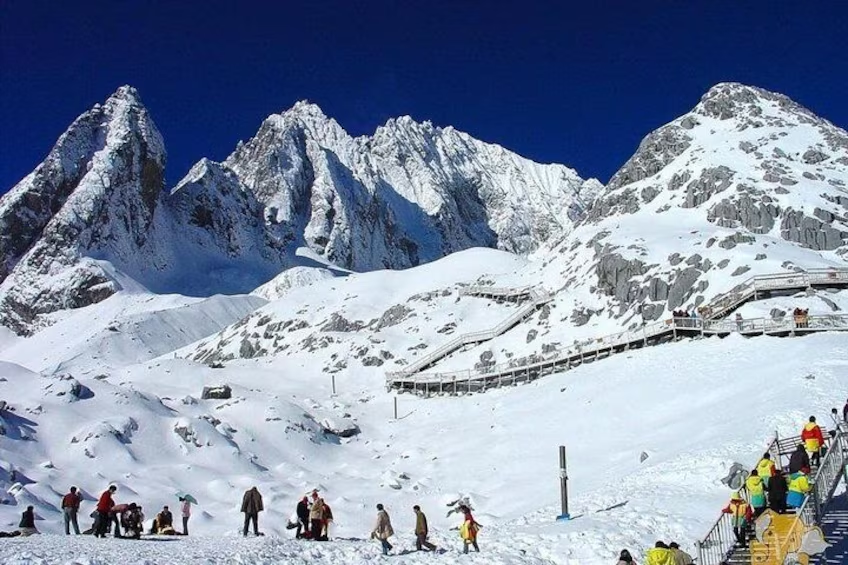







A Travel Guide to Yunnan
Yunnan Province, located in southwestern China, is a land of breathtaking landscapes, rich cultural diversity, and vibrant ethnic traditions. Known as the “South of the Colorful Clouds,” it boasts snow-capped mountains, lush rainforests, ancient towns, and UNESCO World Heritage Sites. With 26 of China’s 56 ethnic groups calling Yunnan home, the province offers a unique blend of cultures, cuisines, and festivals. Whether you’re a nature lover, history buff, or cultural explorer, this guide will help you plan an unforgettable trip to Yunnan.
Why Visit Yunnan?
Yunnan’s appeal lies in its unparalleled diversity. The province spans tropical lowlands in the south to Himalayan peaks in the north, offering everything from rice terraces and karst landscapes to deep gorges and serene lakes. It’s home to iconic attractions like the Stone Forest, Lijiang Old Town, and Yuanyang Rice Terraces, all UNESCO-listed. With over a third of its population belonging to ethnic minorities like the Naxi, Bai, Yi, and Dai, Yunnan provides immersive cultural experiences through colorful markets, traditional crafts, and festivals like the Dai Water-Splashing Festival. Its mild climate, especially in the capital Kunming, makes it a year-round destination.
How to Get There
Yunnan is well-connected to the rest of China and parts of Southeast Asia. The primary entry point is Kunming, the provincial capital, known as the “Spring City” for its pleasant climate.
By Air: Kunming Changshui International Airport is Yunnan’s main hub, offering direct flights from major Chinese cities like Beijing (3 hours), Shanghai (3 hours), and Guangzhou (2.5 hours), as well as international destinations in Southeast Asia (e.g., Bangkok, Singapore) and South Asia. Other regional airports, such as Lijiang Sanyi Airport, Dali Fengyi Airport, and Xishuangbanna Gasa Airport, serve domestic flights and select regional routes. Flight costs from Beijing to Kunming range from $100–$200 one-way, depending on the season.
By Train: High-speed trains connect Kunming to major cities like Beijing (11 hours), Shanghai (10–12 hours), and Chengdu (5–6 hours). Within Yunnan, bullet trains link Kunming to Dali (2 hours), Lijiang (3–3.5 hours), and Shangri-La (7 hours). Book tickets via Trip.com or China Railway’s official app for convenience. Fares from Kunming to Dali start at $20.
By Bus: Long-distance buses are available from neighboring provinces like Sichuan and Guizhou, but they are slower and less comfortable than trains or flights. Within Yunnan, buses connect smaller towns not served by rail, such as Yuanyang or Jianshui.
Tip: Use Kunming as your base for exploring Yunnan. Its transportation network makes it easy to reach other destinations.
Best Time to Visit
Yunnan’s varied geography means weather differs across regions, but its subtropical monsoon climate offers pleasant conditions most of the year:
Spring (March–May): Ideal for Kunming, Dali, and Lijiang, with blooming flowers and mild temperatures (15–25°C). Perfect for the Cherry Blossom Festival in Kunming. Summer (June–September): Cooler in higher-altitude areas like Shangri-La and Lijiang, but rainy in the south (Xishuangbanna). Great for lush greenery and lotus blooms in Puzhehei.
Autumn (October–November): Clear skies and golden harvests make this peak season for photography, especially in Dongchuan Red Land and Yuanyang Rice Terraces. Winter (December–February): Best for snow-capped mountains in Shangri-La and mirror-like rice terraces in Yuanyang. Xishuangbanna remains warm and tropical.
Note: Avoid Chinese holidays like National Day (first week of October) and Spring Festival (January/February) to dodge crowds. Check altitude levels (e.g., Shangri-La at 3,300 meters) and prepare for potential altitude sickness.
Top Destinations
Erhai Lake (洱海)
Erhai Lake, nestled in the heart of Yunnan Province near the historic town of Dali, is one of China’s most picturesque and culturally rich destinations. Known as the “Pearl of the Plateau,” this crescent-shaped alpine lake spans 250 square kilometers, surrounded by the majestic Cangshan Mountains and dotted with traditional Bai minority villages. With its serene waters, vibrant local culture, and endless outdoor activities, Erhai Lake is a must-visit for travelers seeking natural beauty and authentic experiences.





Lugu Lake (泸沽湖)
Nestled on the border of Yunnan and Sichuan provinces, Lugu Lake is a breathtaking alpine lake renowned for its crystal-clear waters, dramatic mountain scenery, and the unique matriarchal culture of the Mosuo people. At an elevation of 2,690 meters, it’s the highest lake in Yunnan, offering a serene escape from urban life. Known as the “Pearl of the Plateau” and the “Kingdom of Women,” Lugu Lake combines natural beauty with cultural intrigue, making it a must-visit destination for travelers seeking tranquility and authenticity.





Old Town of Lijiang (丽江古城)
Lijiang’s Old Town (Dayan) is a living museum of Naxi heritage, with well-preserved buildings dating back to the Ming and Qing dynasties. Its maze-like streets are lined with shops, cafes, and guesthouses, creating a vibrant yet relaxed atmosphere. The town serves as a gateway to natural wonders like Jade Dragon Snow Mountain and Tiger Leaping Gorge, making it a perfect base for both cultural exploration and outdoor adventures. From the rhythmic flow of its canals to the lively evening markets, Lijiang offers a unique glimpse into China’s diverse ethnic tapestry.





Yulong Snow Mountain (玉龙雪山)
Yulong Snow Mountain, also known as Jade Dragon Snow Mountain, is a majestic mountain range located just 15 kilometers north of Lijiang Old Town in Yunnan Province, China. Rising to 5,596 meters at its highest peak, Shanzidou, this snow-capped massif is a sacred site for the Naxi people and a UNESCO World Heritage Site within the Yulong Snow Mountain National Scenic Area. Renowned for its dramatic glaciers, alpine meadows, and cultural significance, it’s a must-visit for nature lovers, adventure seekers, and those eager to explore Yunnan’s rich heritage.





Shuhe Old Town (束河古镇)
Nestled at the foot of the majestic Jade Dragon Snow Mountain, Shuhe Old Town is a tranquil gem just 4 kilometers northwest of Lijiang’s bustling Old Town in Yunnan Province. As one of the earliest settlements of the Naxi people and a well-preserved stop along the ancient Tea Horse Road, Shuhe offers a serene escape with its crystal-clear streams, historic architecture, and rich cultural heritage. Recognized as part of the UNESCO World Heritage Site alongside Lijiang, this quaint town provides a less crowded, more authentic alternative to its famous neighbor.





Stone Forest Scenic Area (石林)
The Stone Forest Scenic Area, located in Shilin Yi Autonomous County, Yunnan Province, China, is a breathtaking natural wonder and a UNESCO World Heritage Site. Known for its towering limestone formations that resemble a forest made of stone, this unique landscape offers visitors an unforgettable experience. Whether you’re a nature enthusiast, a photography lover, or a cultural explorer, the Stone Forest has something for everyone.





Blue Moon Valley (蓝月谷)
Blue Moon Valley is celebrated for its crystal-clear, turquoise waters that shimmer under sunlight, creating a dreamlike scene reminiscent of the Canadian Rockies or Iceland’s glacial lakes. The valley, part of the Jade Dragon Snow Mountain Scenic Area, features four main lakes—Yuye Lake, Jingtan Lake, Blue Moon Lake, and Tingtao Lake—alongside the White Water Terraces, where glacial meltwater flows over natural and enhanced limestone steps. The valley’s name comes from its crescent shape and the river’s blue hue, which turns milky white after rain due to limestone sediment. Steeped in Naxi folklore as the “Love River,” it’s a romantic spot for couples and a haven for photographers seeking iconic shots of snow-capped peaks and vibrant waters.





Potatso National Park (普达措国家公园)
Potatso National Park is a haven of untouched beauty, often described as a real-life Shangri-La. Its crystal-clear lakes, such as Shudu Lake and Bitahai Lake, reflect snow-capped mountains and dense forests, creating postcard-worthy vistas. The park is home to over 20% of China’s plant species, one-third of its mammal and bird species, and nearly 100 endangered species, including black-necked cranes, Yunnan golden monkeys, and leopards, despite covering just 0.7% of China’s land area. Beyond its natural splendor, the park offers cultural experiences through nearby Tibetan villages and spiritual sites, making it a perfect blend of nature and heritage. Whether you’re a hiker, photographer, or culture enthusiast, Potatso promises a magical experience.





Sipsongpanna Botanical Garden (中国科学院西双版纳热带植物园)
Renowned as the “Kingdom of Tropical Plants,” the garden is a global leader in tropical plant preservation and research, showcasing rare species like the Victoria Water Lily, color-changing blooms, and the medicinal Maytenin. Its lush rainforest, vibrant flora, and unique insect life (including firefly swarms at night) create a feast for the senses. The garden’s proximity to Southeast Asia gives it a distinct cultural flavor, with Dai minority influences visible in nearby villages and festivals. Whether you’re hiking through rainforests, photographing exotic plants, or joining a night tour, the garden offers an unforgettable adventure in China’s only tropical region.





CangShan Mountain (苍山)
Cangshan Mountain, also known as Mount Diancang, is a majestic range located just west of Dali Ancient City and Erhai Lake in Yunnan Province, Southwest China. Stretching 48 kilometers from north to south, this national geological park is renowned for its 19 peaks, 18 streams, and rich biodiversity, offering breathtaking views, hiking trails, and cultural landmarks. With its snow-capped peaks, vibrant azalea blooms, and serene Jade Cloud Road, Cangshan is a must-visit destination for nature lovers, adventurers, and those seeking to explore the cultural heritage of the Bai ethnic group.





Tiger Leaping Gorge (虎跳峡)
Nestled in the heart of Yunnan Province, China, Tiger Leaping Gorge is one of the deepest and most spectacular river canyons in the world. Carved by the mighty Jinsha River, a tributary of the Yangtze, this natural wonder offers breathtaking landscapes, challenging hikes, and a glimpse into the rich cultural heritage of the region. Whether you’re an avid hiker or a nature enthusiast, Tiger Leaping Gorge is a must-visit destination.





Where to Eat
Yunnan’s cuisine is as diverse as its people, blending spicy, sour, and fresh flavors:
Kunming: Try Crossing-the-Bridge Noodles (guò qiáo mǐ xiàn), a rice noodle soup with hot broth and fresh ingredients ($3–5). Visit Green Lake Park food stalls for local snacks. Dali: Sample Bai-style grilled fish or er kuai (rice cakes) at Old Town restaurants ($5–10). Lijiang: Enjoy Naxi-style yak meat or su hong dou (crispy kidney beans) in the Old Town ($4–8). Xishuangbanna: Savor Dai-style sticky rice and tropical fruits like mango and durian at Jinghong night markets ($2–5).
Tip: Vegetarians will find plenty of options, especially mushroom dishes and tofu-based specialties. Pair meals with Yunnan’s pu’er tea or local red wines like Shangrila.
Tips for a Great Visit
Language Barrier: English is limited outside major cities. Download Pleco or Google Translate for offline use. Consider a local guide for remote areas. Altitude Awareness: Drink plenty of water in high-altitude areas like Shangri-La to avoid altitude sickness. Respect Local Cultures: Dress modestly when visiting monasteries or minority villages. Ask permission before photographing people.
Cash and Payments: Carry cash (CNY) for rural areas, as mobile payments like WeChat Pay may not accept foreign cards. Safety: Yunnan is generally safe, but watch your belongings in crowded markets. Be cautious of drug-related roadblocks near Myanmar borders. Itinerary Planning: A 7–10-day trip can cover Kunming, Dali, Lijiang, and Shangri-La. Add 3–4 days for Yuanyang or Xishuangbanna. Use bullet trains to save time.
Final Thoughts
Yunnan Province is a traveler’s dream, offering a kaleidoscope of natural wonders, ancient traditions, and vibrant cultures. From the ethereal beauty of Yuanyang’s rice terraces to the spiritual serenity of Shangri-La’s monasteries, every corner of Yunnan tells a story. Plan your visit with flexibility to soak in its diversity, and let this “South of the Colorful Clouds” leave you with memories that last a lifetime.
Happy travels!












Leave a Reply